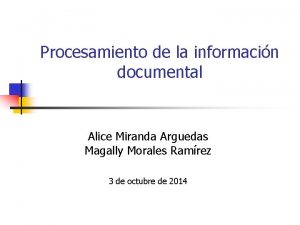JOSE MARIA ARGUEDAS TRANSLATOR Ella Martin ella martinkcl

- Slides: 1

JOSE MARIA ARGUEDAS: TRANSLATOR Ella Martin ella. martin@kcl. ac. uk, Ph. D Department of Spanish, Portuguese and Latin American Studies, KCL, Language Acts and Worldmaking Project ANTHROPOLOGIST Essays and articles published throughout Arguedas’ career, in national newspapers and academic and literary journals. Translation of Quechua speech and dialogue parenthesis, italics MESTIZAJE AND BILINGUALISM Writing from experience, Arguedas writes as a mestizo – the cultural intermediary – living between Quechua and Spanish languages and cultures. His work goes beyond indigenism, representing the whole social, cultural context of the Peruvian Andes. To what extent can we identify a translating approach in Arguedas’ work? How can an exploration of Arguedas’ translating corpus help us to understand his whole body of work? How can we differentiate between the task of translation and the task of cultural translation in Arguedas’ work? Arguedas is recognised as an author and essayist, addressing the relationship between the dominating, dominated and ‘middle’ cultures and languages of the Peruvian Andes in the early twentieth century. The constant presence of translation within his corpus of work is often overlooked. It can, however, reveal a pivotal core to his diverse voices and approaches. Connecting his anthropological and narrative work, Arguedas’ translations, and his comments, show the writer as an adaptable, constantly moving figure, pressed by a need to represent reality. From this perspective, we reveal an urgent, confident and audience driven approach to the task of translation, opposing the often despairing and troubled view of Arguedas that has become standard. REPRESENTING REALITY Arguedas writes, as anthropologist, author and translator, to represent the reality of the Peru that he knows and has lived in. The purpose and origin of all of his work is a need to represent reality, pushing technical ability and style to a secondary status. AUTHOR AND POET Short stories and novels depicting life in the Peruvian Andes, the migration coastal/Andean migration and city life published 1933 -1969. Translation of Quechua songs and poems parallel text, publication of target text (only Spanish) LINGUISTIC CREATIVITY As Arguedas writes in Spanish, to reach a global audience, his need to represent the Quechua and mestizo culture and language of Peru leads to linguistic creativity – a hybridity of language often recognised in Arguedas’ work. The evident agency of the act of translation in this process is, however, often overlooked. CULTURAL TRANSLATION Translation of Quechua terms footnotes, parenthesis, explanations within text When Arguedas has been recognised as a translator, it is as a cultural translator –translating the culture of Andean Peru to the global Spanish-speaking context. His work, however, clearly involves a vast content of translation proper – from one language to another. J. M. Arguedas, in Primer Encuentro de Narradores Peruanos, Arequipa, 1965, (Lima: Casa de la cultura del Perú, 1969). J. M. Arguedas, Canto kechwa, (Lima: Horizonte: 1989). J. M. Arguedas, Indios, Mestizos y Señores, (Lima: Editorial Horizonte, 1985). Alberto Escobar, Arguedas o la utopía de la lengua, (Lima: Instituto de Estudios Peruanos, 1984). Antonio Cornejo Polar, Los universos narrativos de José María Arguedas, (Buenos Aires: Losada, 1973). A. Dingwaney, C. Maier, Between Languages and Cultures: Translation and cross-cultural texts, (Pittsburgh: Pittsburgh University Press, 1996).

